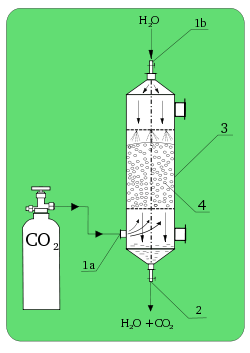Absorption (chemistry)

In chemistry, absorption is a physical or chemical phenomenon or a process in which atoms, molecules or ions enter some bulk phase – gas, liquid or solid material. This is a different process from adsorption, since molecules undergoing absorption are taken up by the volume, not by the surface (as in the case for adsorption). A more general term is sorption, which covers absorption, adsorption, and ion exchange. Absorption is a condition in which something takes in another substance.[1]
In many processes important in technology, the chemical absorption is used in place of the physical process, e.g., absorption of carbon dioxide by sodium hydroxide – such acid-base processes do not follow the Nernst partition law.
For some examples of this effect, see liquid-liquid extraction. It is possible to extract from one liquid phase to another a solute without a chemical reaction. Examples of such solutes are noble gases and osmium tetroxide.[1]
The process of absorption means that a substance captures and transforms energy. The absorbent distributes the material it captures throughout whole and adsorbent only distributes it through the surface.
Equation
If absorption is a physical process not accompanied by any other physical or chemical process, it usually follows the Nernst distribution law:
- "the ratio of concentrations of some solute species in two bulk phases in contact is constant for a given solute and bulk phases":
The value of constant KN depends on temperature and is called partition coefficient. This equation is valid if concentrations are not too large and if the species "x" does not change its form in any of the two phases "1" or "2". If such molecule undergoes association or dissociation then this equation still describes the equilibrium between "x" in both phases, but only for the same form – concentrations of all remaining forms must be calculated by taking into account all the other equilibria.[1]
In the case of gas absorption, one may calculate its concentration by using, e.g., the Ideal gas law, c = p/RT. In alternative fashion, one may use partial pressures instead of concentrations.
Types of absorption
Absorption is a process that may be chemical (reactive) or physical (non-reactive).
Physical absorption
Physical absorption or non-reactive absorption is made between two phases of matter: a liquid absorbs a gas, or a solid absorbs a liquid.
When a liquid solvent absorbs a gas mixture or part of it, a mass of gas moves into the liquid. For example, water may absorb oxygen from the air. This mass transfer takes place at the interface between the liquid and the gas, at a rate depending on both the gas and the liquid. This type of absorption depends on the solubility of gases, the pressure and the temperature. The rate and amount of absorption also depend on the surface area of the interface and its duration in time. For example, when the water is finely divided and mixed with air, as may happen in a waterfall or a strong ocean surf, the water absorbs more oxygen.
When a solid absorbs a liquid mixture or part of it, a mass of liquid moves into the solid. For example, a clay pot used to store water may absorb some of the water. This mass transfer takes place at the interface between the solid and the liquid, at a rate depending on both the solid and the liquid. For example, pots made from certain clays are more absorbent than others. Absorption is essentially a molecule attaching themselves to a substance and will not be attracted from other molecules.
Chemical absorption
Chemical absorption or reactive absorption is a chemical reaction between the absorbed and the absorbing substances. Sometimes it combines with physical absorption. This type of absorption depends upon the stoichiometry of the reaction and the concentration of its reactants.[2]
References
- 1 2 3 McMurry, John (2003). Fundamentals of Organic Chemistry (Fifth ed.). Agnus McDonald. p. 409. ISBN 0-534-39573-2.
- ↑ Leiviskä, Tiina; Gehör, Seppo; Eijärvi, Erkki; Sarpola, Arja; Tanskanen, Juha (10 April 2012). "Characteristics and potential applications of coarse clay fractions from Puolanka, Finland". Central European Journal of Engineering. 2 (2): 239–247. doi:10.2478/s13531-011-0067-9.